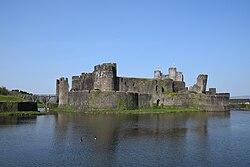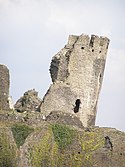Caerphilly (hrad)
| Caerphilly | |
|---|---|
 Celkový pohled na hrad | |
| Základní informace | |
| Výstavba | 1268 |
| Poloha | |
| Adresa | Caerphilly, |
| Nadmořská výška | 94,9 m |
| Souřadnice | 51°34′33,79″ s. š., 3°13′13,2″ z. d. |
| Další informace | |
| Kód památky | 13539 |
| Web | Oficiální web |
| Některá data mohou pocházet z datové položky. | |
Hrad Caerphilly (velšsky Castell Caerffili) je druhý nejrozsáhlejší hrad ve Velké Británii, leží 10 kilometrů severně od Cardiffu ve Walesu a rozprostírá se na ploše větší než 30 akrů.
Caerphilly je jednou z nejrozsáhlejších středověkých pevností v Británii. Jeho stavbu započal v roce 1268 anglo-normanský lord Gilbert z Clare. Hrad byl upraven ve 14. století. Soustředné kruhy kamenného a vodního opevnění jsou impozantní ještě dnes.
Je proslulý svou jihovýchodní „šikmou věží“ (následek bojů během občanské války). Působivá aula (great hall) je dnes využívána k různým účelům. Vstupné pro dospělé činí 6 liber.
Galerie
Externí odkazy
 Obrázky, zvuky či videa k tématu Caerphilly na Wikimedia Commons
Obrázky, zvuky či videa k tématu Caerphilly na Wikimedia Commons - Oficiální stránky Archivováno 21. 8. 2011 na Wayback Machine
Média použitá na této stránce
Šikmá věž hradu Caerphilly, Wallie
(c) Brian Jenkins, CC BY-SA 3.0
Scaled-replica siege weapons at Caerphilly Castle, south Wales
Autor: hugh llewelyn, Licence: CC BY-SA 2.0
Caerphilly Castle (Castell Caerffili), Glamorgan, 19 April 2019. It was built, next to the site of an old Roman fort, by Gilbert de Clare, Earl of Gloucester, in 1268-90 as part of the Norman invasion of Wales, although the local Welsh prince, Llywelyn ap Gruffudd, burnt the partly constructed castle in 1270 but subsequently he was defeated and later killed in 1282. It was again attacked by Morgan ap Meredudd during the rebellion by Madog ap Llywelyn in 1294 and again by Llywelyn Bryn in his rebellion of 1316 but ultimately the Anglo-Norman conquest of Wales succeeded. In the English Civil War, South Wales was Royalist but the Parliamentarians took Caerphilly in 1646. They may have subsequenly slighted the Castle although subsidence may have been the main cause of it's partial collapse. The Marquess of Bute restored the castle in 1928-39. The castle is the biggest in Wales, second in the UK. It had the most elaborate water defences of any British castle and introduced the concentric wall defences to Britain. Pictured is the castle from the south with the South Lake and, to the right, the Outer Main Gatehouse. To the left is the bridge to the Western Island, an important part of the defensive system and may have been to shelter the town's population in time of seige.
Autor: hugh llewelyn, Licence: CC BY-SA 2.0
Caerphilly Castle (Castell Caerffili), Glamorgan, 19 April 2019. It was built, next to the site of an old Roman fort, by Gilbert de Clare, Earl of Gloucester, in 1268-90 as part of the Norman invasion of Wales, although the local Welsh prince, Llywelyn ap Gruffudd, burnt the partly constructed castle in 1270 but subsequently he was defeated and later killed in 1282. It was again attacked by Morgan ap Meredudd during the rebellion by Madog ap Llywelyn in 1294 and again by Llywelyn Bryn in his rebellion of 1316 but ultimately the Anglo-Norman conquest of Wales succeeded. In the English Civil War, South Wales was Royalist but the Parliamentarians took Caerphilly in 1646. They may have subsequenly slighted the Castle although subsidence may have been the main cause of it's partial collapse. The Marquess of Bute restored the castle in 1928-39. The castle is the biggest in Wales, second in the UK. It had the most elaborate water defences of any British castle and introduced the concentric wall defences to Britain. Pictured is the Inner Ward looking to the Inner Main (Eastern) Keep-Gatehouse with the Great Hall on the left.











